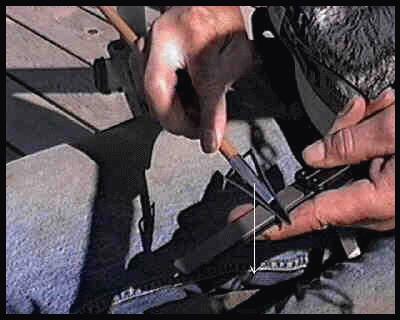
Probably the most important piece of equipment
the hunting archer takes to the field with him is a well designed,
properly sharpened broadhead. There are several different types of
edges and even more different ways to apply those edges. The most
common edge being used today, as evidenced by the popularity of the
insert type modular head, is the smooth razor edge. The type of edge
that will cleanly shave hair off your arm. Although it will do the
job, it is my opinion that a properly file sharpened head is a more
effective cutting blade, as well as being much more durable and quicker
to apply in the field. There are several different methods for obtaining
this type of edge. The following instructions describe the method I
use. The whole process can be done in less than 2 minutes with nothing
more than a good 6" mill bastard single cut file.
Step 1: Hold the arrow so that the broadhead is pointing away from you and, with the flat side of the file, stroke the bevels from back of head toward the point. One stroke on each bevel and continue this process until the bevels have met and a small burr is formed on the edge. On most heads, such as the Hill being worked here, the ferrel can be used as a guide.

Step 2: The burr now needs to be removed. To do this, use the flat NARROW side of the file and, with no pressure other than the weight of the file, run the file down the edge from back of head toward the front. Just a few strokes should remove the burr.

Step 3: Now hold the arrow so that the point is facing toward you and grip the file at the fat end (end opposite the handle if present). Using the CORNER, or edge, of the file and with a great deal of pressure, run down the edge from back of head toward the point. This will place small teeth in the blade. Turn the head over and very lightly repeat on the opposing bevel. The edge should now feel rough to the touch.

Step 4: Again using the flat NARROW side of the file, lightly stroke each bevel several times from back of head toward the front. One stroke per bevel and turn head over to repeat on the other bevels. This will align the edge and remove much of the roughness.
Step 5: Using a piece of leather, strop the head to clean and further align the edge. You should now have an edge that has a little "bite" to it and is extremely durable. Unlike the smooth, razor edge, this blade will retain it's cutting ability after coming into contact with bone.

Step 6 (optional): If you wish to further refine the edge you can do so by using a flat EZE-LAP steel. Hold the steel in left hand and very lightly stroke the head from point to back INTO the steel on all four bevels. Like a stone, the EZE-LAP will remove metal so only make one or two strokes per bevel or you will remove the teeth you have placed in the edge. Again, strop the edges on a piece of leather to clean and polish the head.

